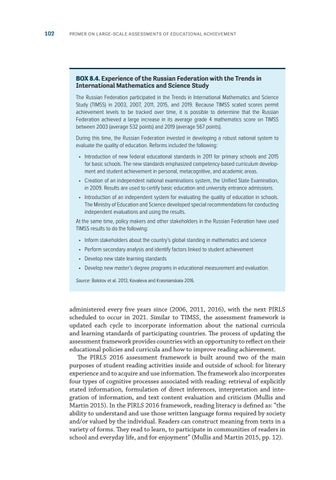102
PRIMER ON LARGE-SCALE ASSESSMENTS OF EDUCATIONAL ACHIEVEMENT
BOX 8.4. Experience of the Russian Federation with the Trends in International Mathematics and Science Study The Russian Federation participated in the Trends in International Mathematics and Science Study (TIMSS) in 2003, 2007, 2011, 2015, and 2019. Because TIMSS scaled scores permit achievement levels to be tracked over time, it is possible to determine that the Russian Federation achieved a large increase in its average grade 4 mathematics score on TIMSS between 2003 (average 532 points) and 2019 (average 567 points). During this time, the Russian Federation invested in developing a robust national system to evaluate the quality of education. Reforms included the following: • Introduction of new federal educational standards in 2011 for primary schools and 2015 for basic schools. The new standards emphasized competency-based curriculum development and student achievement in personal, metacognitive, and academic areas. • Creation of an independent national examinations system, the Unified State Examination, in 2009. Results are used to certify basic education and university entrance admissions. • Introduction of an independent system for evaluating the quality of education in schools. The Ministry of Education and Science developed special recommendations for conducting independent evaluations and using the results. At the same time, policy makers and other stakeholders in the Russian Federation have used TIMSS results to do the following: • Inform stakeholders about the country’s global standing in mathematics and science • Perform secondary analysis and identify factors linked to student achievement • Develop new state learning standards • Develop new master’s degree programs in educational measurement and evaluation. Source: Bolotov et al. 2013; Kovaleva and Krasnianskaia 2016.
administered every five years since (2006, 2011, 2016), with the next PIRLS scheduled to occur in 2021. Similar to TIMSS, the assessment framework is updated each cycle to incorporate information about the national curricula and learning standards of participating countries. The process of updating the assessment framework provides countries with an opportunity to reflect on their educational policies and curricula and how to improve reading achievement. The PIRLS 2016 assessment framework is built around two of the main purposes of student reading activities inside and outside of school: for literary experience and to acquire and use information. The framework also incorporates four types of cognitive processes associated with reading: retrieval of explicitly stated information, formulation of direct inferences, interpretation and integration of information, and text content evaluation and criticism (Mullis and Martin 2015). In the PIRLS 2016 framework, reading literacy is defined as: “the ability to understand and use those written language forms required by society and/or valued by the individual. Readers can construct meaning from texts in a variety of forms. They read to learn, to participate in communities of readers in school and everyday life, and for enjoyment” (Mullis and Martin 2015, pp. 12).

